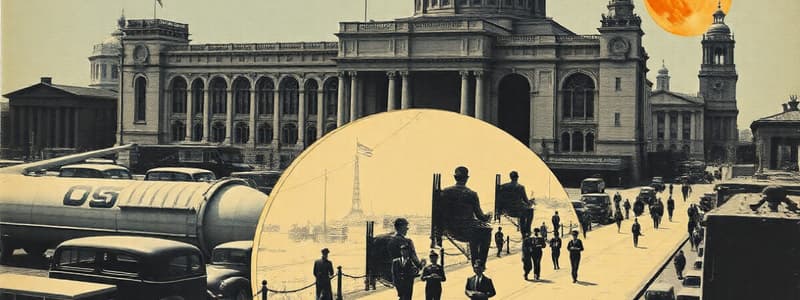Podcast
Questions and Answers
What significant event in 1948 contributed to a surge in demand for American goods?
What significant event in 1948 contributed to a surge in demand for American goods?
- The Korean War
- The Vietnam War
- The Soviet Union launching Sputnik
- The Marshall Plan (correct)
The G.I. Bill primarily benefited African Americans, providing them with equal access to housing loans and economic opportunities.
The G.I. Bill primarily benefited African Americans, providing them with equal access to housing loans and economic opportunities.
False (B)
What factor significantly contributed to the consumer boom during the post-war period?
What factor significantly contributed to the consumer boom during the post-war period?
The accumulation of savings by Americans, including returning soldiers.
The widespread adoption of ____ in the 1950s further fueled consumer spending.
The widespread adoption of ____ in the 1950s further fueled consumer spending.
Match the following presidents with their respective economic policies discussed in the text:
Match the following presidents with their respective economic policies discussed in the text:
What did Eisenhower refer to as the 'Military-Industrial Complex'?
What did Eisenhower refer to as the 'Military-Industrial Complex'?
The Space Race during the 1960s resulted in a decrease in job creation in the United States.
The Space Race during the 1960s resulted in a decrease in job creation in the United States.
What was the economic impact of the Vietnam War on the U.S. economy?
What was the economic impact of the Vietnam War on the U.S. economy?
During the 1960s, the U.S. government spent approximately $______ billion on space research.
During the 1960s, the U.S. government spent approximately $______ billion on space research.
Match the following U.S. presidents with their economic policies:
Match the following U.S. presidents with their economic policies:
Which sector of the economy was severely affected by the Oil Crises of 1973 and 1979?
Which sector of the economy was severely affected by the Oil Crises of 1973 and 1979?
The term 'stagflation' refers to a combination of high economic growth and low inflation.
The term 'stagflation' refers to a combination of high economic growth and low inflation.
In what year was NASA established?
In what year was NASA established?
The economic policies under Ronald Reagan are often referred to as ______.
The economic policies under Ronald Reagan are often referred to as ______.
What was one significant effect of American globalisation in the 1960s?
What was one significant effect of American globalisation in the 1960s?
The wealth gap in America widened significantly due to Reagan's economic policies.
The wealth gap in America widened significantly due to Reagan's economic policies.
What economic challenge did America face by 1973?
What economic challenge did America face by 1973?
The economic landscape of the U.S. underwent profound changes between 1945 and ______.
The economic landscape of the U.S. underwent profound changes between 1945 and ______.
Match the following economic events with their consequences:
Match the following economic events with their consequences:
Flashcards
Post-War Economic Boom
Post-War Economic Boom
The period following World War II (1945-1949) characterized by strong economic growth, low unemployment, and high consumer spending in the United States.
Marshall Plan
Marshall Plan
A US government program that provided financial aid to European countries after WWII to help them rebuild their economies. This aid also boosted American exports.
Baby Boom
Baby Boom
The significant increase in births in the United States between 1946 and 1964, fueled by returning soldiers and economic prosperity.
G.I. Bill
G.I. Bill
Signup and view all the flashcards
Consumer Boom
Consumer Boom
Signup and view all the flashcards
American Golden Age
American Golden Age
Signup and view all the flashcards
Racial Discrimination in the 1950s
Racial Discrimination in the 1950s
Signup and view all the flashcards
Military-Industrial Complex
Military-Industrial Complex
Signup and view all the flashcards
Post-War Economic Boom (1945-1973)
Post-War Economic Boom (1945-1973)
Signup and view all the flashcards
Space Race Economic Impact
Space Race Economic Impact
Signup and view all the flashcards
Rise of Globalization (1960s)
Rise of Globalization (1960s)
Signup and view all the flashcards
Economic Challenges of the 1970s
Economic Challenges of the 1970s
Signup and view all the flashcards
Vietnam War's Economic Effects
Vietnam War's Economic Effects
Signup and view all the flashcards
Reaganomics
Reaganomics
Signup and view all the flashcards
Reagan's Economic Legacy
Reagan's Economic Legacy
Signup and view all the flashcards
The Golden Age of the U.S. Economy
The Golden Age of the U.S. Economy
Signup and view all the flashcards
Government Intervention vs. Free Market
Government Intervention vs. Free Market
Signup and view all the flashcards
Keynesian Economics
Keynesian Economics
Signup and view all the flashcards
Free-Market Principles
Free-Market Principles
Signup and view all the flashcards
Income Inequality
Income Inequality
Signup and view all the flashcards
Poverty
Poverty
Signup and view all the flashcards
Study Notes
Post-War Economic Developments (1945-1989)
-
Post-war boom (1945-1970s): The US experienced substantial economic growth after World War II, characterized by low unemployment and high consumer spending fueled by accumulated savings and the Marshall Plan.
-
Marshall Plan impact: The $3.6 billion Marshall Aid facilitated European reconstruction, creating demand for US goods and fueling the post-war economic surge. Increased spending, including on television sets (from 10,000 in 1945 to 6 million in 1950), and the introduction of credit cards further boosted consumerism.
-
Baby Boom and G.I. Bill: The surge in population (baby boom) created higher demand for housing, goods, and infrastructure. The G.I. Bill aided veterans in obtaining housing, and highway construction under Presidents Truman and Eisenhower transformed the nation. However, these benefits were disproportionately distributed, ignoring racial discrimination and excluding African Americans from much of the prosperity.
-
Military-Industrial Complex: President Eisenhower warned of the growing alliance between defense industries and government spending, highlighting the significant contribution of arms production to the economy, notably in the Sun Belt states. This highlighted a potential risk of economic dependence on defense spending impacting US foreign policy.
-
Space Race impact: The US government significantly increased spending on space technology following the Soviet Union's launch of Sputnik, creating jobs and driving technological development. NASA investments totalled ~$300 billion in the 1960s, generating ~400,000 jobs, with significant spillover effects, notably in the computer industry in Silicon Valley.
-
Rise of Globalization: US economic influence expanded internationally through multinational corporations. US overseas investment increased from $11 billion to $67 billion, contributing to global dominance and significant international profits for US companies.
-
Vietnam War impact: Massive military spending of $85 billion by 1969 burdened the US economy, combined with the administration's refusal to raise taxes, creating inflation and crippling social programs. This fiscal imbalance caused significant economic strain leading to the economic challenges of the 1970s.
-
1970s Economic Challenges: Increased competition from the EEC (European Economic Community) and Japanese industries significantly challenged US economic dominance. The Detroit auto industry declined, unemployment rose. The oil crises of 1973 & 1979 destabilized the economy, leading to the term 'stagflation' (high inflation and economic stagnation). Various governmental response attempts (Nixon, Ford, Carter) proved ineffective.
-
Reagan's Economic Policies (1980s): Reagan's "Reaganomics" emphasized tax cuts, deregulation, and reduction in social programs. Initially, the policy reduced unemployment and inflation, but it widened the income gap due to benefits going disproportionately to the wealthy. The benefits for the average citizen were mixed as welfare programmes were hurt.
-
Reagan's Legacy: Reagan's policies had enduring effects on subsequent administrations. Lower taxes and fewer regulations benefited businesses and the wealthy. Meanwhile the impact on social welfare programmes (e.g., food stamps, housing support) negatively affected the less well-off. Military spending significantly increased, potentially at the expense of social welfare programs. His economical approach strongly influenced later political figures.
Conclusion
- The period between 1945 and 1989 saw substantial transformations in the US economy, influencing modern economic policy. The post-war period was marked by prosperity, but it was impacted by economic shocks in the 1970s and Reagan's response that shifted economic ideologies.
Studying That Suits You
Use AI to generate personalized quizzes and flashcards to suit your learning preferences.




